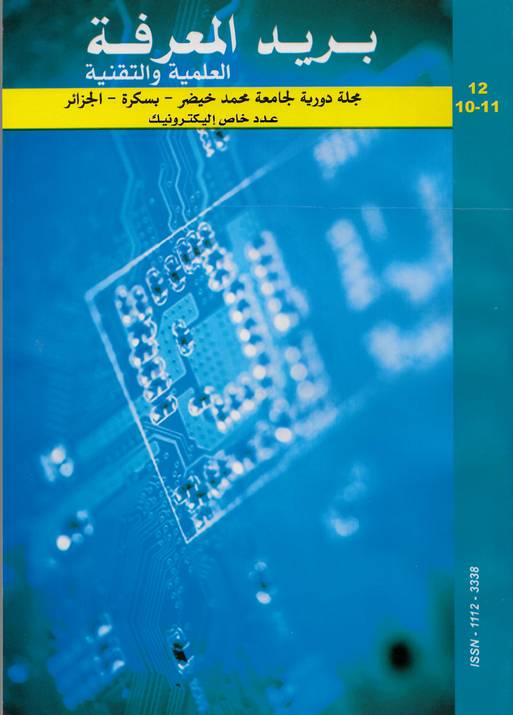THE EFFECTIVENESS OF FUZZY LOGIC CONTROL FOR PV PUMPING SYSTEM
Résumé
This paper presents an optimal operation of a photovoltaic pumping system. An analysis by witch the dynamic performances of
a permanent magnet brushless DC (PMBLDC) motor is controlled through a hysteresis current loop and an outer speed loop
with different controllers. The dynamics of the drive system with (PI) and a Fuzzy logic (FL) speed controllers are presented.
In order to optimize the overall system efficiency, a maximum power point tracker is also used. Simulation is carried out by
formatting the mathematical model for photovoltaic source, MPPT, motor and pump load. The results with FL speed controller
show improvement in transient response of PMBLDC drive over conventional PI. The effectiveness of the FL controller is also
demonstrated.
Références
55
[13] T. F. WU and al. “A Fuzzy-Logic-Controlled Single-Stage
Converter for PV-Powered Lighting System Application”,
IEEE Trans. IE, Vol. 47, No. 2, 2000, pp: 287-296
[14] C. L. P. SWAMY and al. “Dynamic Performance of a
permanent Magnet Brushless DC Motor Powered by a PV
Array for Water Pumping” Solar Energy Materials and Solar
Cells, Vol. 36, 1995, pp: 187-200.
[15] A. Betka, A. Attali “ Optimization of a photovoltaic
pumping system based on the optimal control theory” Solar
Energy, Vol. 84, N°7, july2010, pp 1273-1283.[1] G. B. SHRERTHA, L. GOEL, “A Study On Optimal Sizing
Of Stand Alone Photovoltaic Stations” IEEE Trans. on EC,
Vol. 13, No. 4, 1998, pp: 373-377.
[2] J. SAMIN and al. “Optimal sizing of Photovoltaic Systems
in Varied Climates” Solar Energy, vol.6, No.2, 1997, pp: 97-
107.
[3] K. KALAITZAKIS“Optimal PV System Dimensioning with
Obstructed Solar Radiation” Renewable Energy, Vol. 7, No.
1, pp: 51-56.
[4] Z. ZINGE, “Optimum Operation of a Combined System pf a
Solar Cell Array and a DC Motor”, IEEE Trans. on PAS,
Vol. PAS-100, No. 3, 1981, pp: 1193-1197.
[5] J. APPELBAUM, “Starting and Steady State Characteristics
of DC Motor Powered by Solar Cell Generator”, IEEE
Trans. on EC, Vol. 1, No. 1, 1986, pp: 17-25.
[6] M. M. SAIED, “Matching of DC Motor to Photovoltaic
generator for Maximum Daily Gross Mechanical Energy”
IEEE Trans. on EC, Vol. 3, No. 3, 1988, pp: 465-471.
[7] J. Appelbaum, M. S. Sarme, “The Operation of Permanent
Magnet DC motors Powered by a Common Source of Solar
Cells”, IEEE Trans. on EC, Vol. 4, No. 4,1989, pp: 635-642.
[8] S. SINGER, “Starting Characteristics Of Direct Current
Motors Powered By Solar Cells”, IEEE Trans. on EC, Vol.
8, No. 1, 1993, pp: 47-52.
[9] V. C. MUMMADI, “Steady State And Dynamic
Performances Analysis Of PV Supplied DC Motors Fed
From Intermediate Power Converter”, Solar Energy
Materials & Solar Cells, Vol-61, 2000, pp: 365-381.
[10] S. R. BHAT, and al, “Performance Optimization of
Induction Motor-Pump System Using Photovoltaic Energy
Source”, IEEE Trans. on IA, Vol. 23, No. 6, 1987, pp: 995-
1000.
[11] M. VEERACHARY, N. YADAIAH, “ANN Based Peak
Power Tracking For PV Supplied Dc Motors”, Solar Energy,
Vol. 69, N0. 4, 2000, pp: 343-350.
[12] T. HIYAMA, and al. “Neural Network Based Estimation Of
Maximum Power Generation From PV Modules Using
Environmental Information”, IEEE Trans. on EC, Vol. 12,
No. 3, 1997, pp: 241-247.


